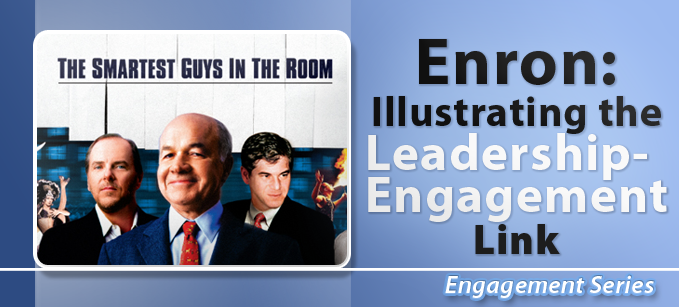Enron: Illustrating the Leadership-Engagement Link

In this series, we are talking about 6 key drivers that come up time and again in the research on employee engagement. This is part of #4: Good Company Leadership.
By leadership, we are including:
- The leadership team (the CEO, senior management, the board and key managers)
- The overarching strategy (vision, mission, values)
- The key systems put in place by "those at the wheel"
Leaders can have a truly awesome effect on engagement, whether the effect is "positive-good" (e.g. Jack Welch at GE) or "positive-bad" (e.g. Ken Lay and Jeff Skilling at Enron). It's important to note that positive(high levels of employee engagement) doesn't necessarily mean that it's actually a good thing for the company or the community - and this is what we mean by a "positive-bad" effect.
To help explain why this and the link with leadership to engagement is so crucial, consider the following company statement:
"The highest goal of management should be to deliver optimal financial performance with a workforce that is fully engaged."
Do you agree?
We certainly don't.
The company that embraced this philosophy was Enron. Once the 7th largest in revenue in the US, Enron was named by Fortune as "most innovative" not once, but 6 years in a row. To the public, it was heralded as a new oasis of great leadership. Eventually that image was revealed as a desert mirage of greed, manipulation and gross fraud.

The chain of events that led to Enron’s downfall were both simple and very complex. In a word, it can be traced back to leadership, or lack there of...
"Kenneth Lay, CEO, hired Jeff Skilling to assist in developing Enron’s business strategy. Skilling instituted the performance review committee (PRC), which became known as the harshest employee-ranking system in the country. Associates came to feel that the only real performance measure was the amount of profits they could produce. In order to achieve top ratings, everyone in the organisation became instantly motivated to “do deals” and post earnings. Employees were regularly rated on a scale of 1 to 5, with 5s usually being fired within six months. The lower an employee’s PRC score, the closer he or she got to Skilling, and the higher the score, the closer he or she got to being shown the door. Skilling’s division was known for replacing up to 15% of its workforce every year. Fierce internal competition prevailed and immediate gratification was prized above long-term potential. Paranoia flourished and trading contracts began to contain highly restrictive confidentiality clauses. Secrecy became the order of the day for many of the company’s trading contracts, as well as its disclosures."
It turned into a kind of ugly corporate natural selection - hire the most driven, ambitious, competitive and greedy traders and weed out the rest - slowly evolving the Enron business into a monster. "The inmates" (traders) it was noted in one documentary, were said to have come to rule the asylum and Skilling was warned by one senior executive "Jeff you've got a real problem, they will cut your throat if they think it will get them to the trough sooner".
Enron's traders could potentially make huge sums of money, which created a super motivated atmosphere. However, being fully engaged doesn't necessarily mean that the company is doing the right thing. This is the task of good management and leadership - to create strategies and systems in a way that supports sustainable, long-term decisions that leave a positive and enduring legacy for both internal stakeholders and the community.
Leaders, of course, need to communicate their values, but most importantly they need to walk them. Enron’s core values of respect, integrity, communication and excellence (RICE) were superficially espoused, but their leaders had created a system that rewarded behaviours based on profit, risk, secrecy and disregard for the common good.
Enron's full story is breathtaking. This post is not intended to sum up the events that led to its demise, but to simply use it as an illustration of how leadership and engagement are closely tied together; engagement means nothing without good leadership.
Leadership creates a clear vision of the future, aligns people to that vision and supports its people with systems that are socially responsible.
People need certain things from their leaders in order to be fully engaged. In order to create "positive-good" engagement, here is a list of 10 keys that leaders can keep in mind:
- Create systems that reward behaviours that are in the long-term interest, not just the short term
- Walk their talk (practice their values)
- Build trust (demonstrate respect, integrity, promote transparency, do what they say)
- Show a sincere interest in employee’s well being
- Care about the well being of their customers
- Develop a leadership pipeline for the future
- Act in the best interest of both stakeholders and the community
- Ensure employees have appropriate decision-making capability and autonomy
- Ensure employees have resources needed to perform jobs in a high quality way
- Communicate a clear vision for long-term success
As a key driver of engagement, good company leadership can have a powerful influence over the impact of engagement. With an engaged workforce willing to follow their leader, it is important to have that power wielded for good and not for evil.
Profiling Tools:

Theo Winter
Client Services Manager, Writer & Researcher. Theo is one of the youngest professionals in the world to earn an accreditation in TTI Success Insight's suite of psychometric assessments. For more than a decade, he worked with hundreds of HR, L&D and OD professionals and consultants to improve engagement, performance and emotional intelligence of leaders and their teams. He authored the book "40 Must-Know Business Models for People Leaders."

/Workshop%205_%20Embracing%20Change%20Workshop.png?width=374&name=Workshop%205_%20Embracing%20Change%20Workshop.png)
/The%2010%20Minute%20Emotional%20Intelligence%20Activity%20that%20changes%20lives.png?width=374&name=The%2010%20Minute%20Emotional%20Intelligence%20Activity%20that%20changes%20lives.png)
We Would Like to Hear From You (0 Comments)